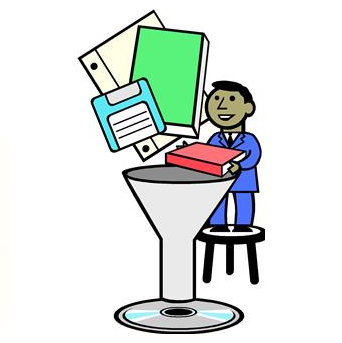Many of you have likely attended at least one LegalTech trade show at some point. LegalTech New York (LTNY) happens every year in the late January/early February time frame and there is also a LegalTech West Coast (LTWC) show later in the year (this year it was in mid-May). LTNY and LTWC usually have several good sessions, as well as the latest product and service offerings from exhibitors. But, what if you can’t make it to one of these shows?
For those who can’t travel, but still wish to stay up to date on the latest trends, American Lawyer Media (ALM) has begun offering Virtual LegalTech (VLT) sessions quarterly. This is the second full year that these sessions have been available and the sessions for this quarter are being held tomorrow (many of which are CLE eligible, at least in certain jurisdictions). These online sessions are free to attend – you simply have to provide information to obtain a login ID and password.
VLT is set up just like an actual trade show. There’s a “campus” with two exhibit halls, a CLE Center auditorium, a lounge and a resource room. Copies of slides for presentations are usually available a short time after the presentation is conducted in the resource room. You can even check out vendor “booths” in the virtual exhibit halls!
For tomorrow’s “show”, there are several sessions related to eDiscovery concepts, including:
9:00 am – 10:00 am ET:
Recover Costs, Improve Profits & Reduce Risk: Cost Recovery for eDiscovery Content
Description: Law firms, like all businesses, are constantly looking for ways to reduce costs and improve profits. Traditional cost recovery focuses on tracking, managing and assigning costs associated with activities such as scanning, faxing, printing, and e-mailing. To make documents eDiscoverable at point of capture, documents should be tagged with metadata such as filename, matter, client and billing code information; easing the burden on staff and lawyers, so more time can be spent strategizing the case and less time at the device handling administrative tasks. This session will explore various practices for integrating eDiscovery into traditional cost recovery tactics. Industry experts will also discuss tips and tricks to help profits soar while also reducing risk of data loss.
Speakers are: Chris Wyszkowski – Nuance Communications; Thomas Goldman, JD – Author of Technology in the Law Office, Second Edition
11:00 am – 12:00 pm ET:
Attack of the Clouds: Virtual Privacy & Online Security
Description: Look at cloud computing through the lens of eDiscovery and its easy to become confused as to whether the cloud is a great equalizer; allowing firms of all sizes to spend less time and money on the mechanics of eDiscovery, or the refuge of the naïve for whom its only a matter of time until their miracle solution falls flat. The cloud offers great cost savings and convenience to law practitioners, but there are very real concerns about cloud privacy and security.
Our expert panel will share a unique legal and technical perspective on privacy and security in the cloud, looking at case law regarding the liability of cloud providers and how it impacts the health of the cloud industry. This informative discussion will span legal and cybersecurity issues with the cloud, giving you a clear view of the risks and rewards involved with this exciting new technology.
Speakers are: Caitlyn Murphy, Esq. – Senior Product Manager, AccessData Group; Joshua Gilliland – Attorney and Author of the Bow Tie Law Blog; Jeffrey Dye – CISSP, Network Defense and Digital Forensics, General Dynamics
12:00 pm – 1:00 pm ET:
Unbundling Litigation: Selecting and Using E-Discovery Counsel
Description: There was a time when corporations expected litigation counsel to handle all aspects of litigation, including discovery. However, as e-discovery becomes more complex and mistakes are increasingly common, there is a trend toward unbundling litigation and selecting a separate e-discovery counsel. E-discovery counsel is often a separate law firm that specializes in e-discovery issues and can do the work better, faster and cheaper than general litigation lawyers. This panel will discuss the pros and cons of using e-discovery counsel in complex litigation. We will also discuss best practices for selecting and integrating e-discovery counsel into the litigation process.
Speakers are: Chris Dale – Moderator and Author of the eDisclosure Information Project (UK); Darryl Shetterly – Partner, LeClair Ryan, LLC; William Belt – Partner and Team Leader, Discovery Solutions Practice, LeClair Ryan LLC; Heather Bryden – Assistant General Counsel. e-Discovery Manager, Capitol One Bank
2:00 pm – 3:00 pm ET:
Information Security – A Systematic Approach to Protecting Your Organization’s Data During the eDiscovery Process
Description: Information security is a high priority concern for both corporations and law firms in the eDiscovery process. The challenge is translating this concern into practice. Failing to take special care to ensure security can expose your company or client’s most critical information and breaches the ethical standards of client-lawyer confidentiality. A centrally managed, systematic approach based upon a formal management system is the best way to ensure the highest level of information security.
In this session, we will offer an overview of approaches that will allow lawyers to ethically meet their professional obligations related to information security best practices, standards and processes, such as:
- Why a process driven approach to information security is needed?
- Who should be responsible for information security in the eDiscovery process?
- What are the hallmarks of good information security?
- How to evaluate information security practices in your eDiscovery partner or vendor?
Speakers are: Doug Stewart – EnCE, Director of Technology, Daegis; Andy Teichholz, Esq. – Senior eDiscovery Consultant, Daegis; Mark Michels – Former eDiscovery and Litigation Counsel, Cisco; Aaron Crews – eDiscovery Counsel, Littler Mendelson
3:00 pm – 4:00 pm ET:
Judge's Panel: Leveraging Technology to Reduce the Challenges of Discovery
Description: What are the most important facts that will allow you to leverage the technology created to assist attorneys with litigation and discovery? This group of distinguished judges will spotlight decisive concerns, Federal Rules of Civil Procedure reform and what can be done to alleviate the responsibility and obligation that is essential to compliant discovery practice. The most technologically advanced methods to effectively approach the planning and managing of litigation preparation to meet key requirements will be discussed. This session is a “must attend” for those interested is lessening the burden of discovery.
Speakers are: Hon. Frank Maas – Magistrate Judge, Southern District of New York; Hon. Patty Shwartz – Magistrate Judge, District of Newark, NJ and Adjunct Professor of Law, Fordham University Law School; Hon. Ron Hedges – Former Magistrate Judge
4:00 pm – 5:00 pm ET:
Cross-Border Discovery and Investigations – Developing a Strategic Response Plan
Description: Companies operating in the global economy face increasing scrutiny from regulators in the US and Europe, with enhanced risk of related cross-border litigation and discovery. Join Howard Sklar, Senior Counsel of Recommind and Denise Backhouse, Associate, eData Practice, Morgan Lewis, as they address the data management issues in developing a strategic, cost-effective plan for responding to international discovery and investigations:
- Data protection issues in European/US investigations and discovery: the legal framework and recent developments
- Preparing for investigations and discovery: creating a response plan; establishing a team; effective communication and privilege protection
- Best practices for handling data in international matters
Speakers are: Denise E. Backhouse – Associate, eData Practice Morgan Lewis; Howard Sklar – Senior Counsel Recommind, Inc.
To “attend” any of these sessions or learn more about Virtual Legal Tech, go to Virtual Legal Tech Show.
So, what do you think? Do you attend virtual seminars? Please share any comments you might have or if you’d like to know more about a particular topic.






